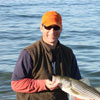Fishing Tricks and Tips
By Tom Keer
Feb 25, 2015
One major difference between professional and recreational anglers is the number of fishing tricks and tips up their sleeve.
One major difference between professional and recreational anglers is the number of fishing tricks and tips up their sleeve. Pros fish based on patterns and methods, and that approach leads to a greater understanding of their environment and their quarry. Whether you’re looking for bass, crappie, trout, striped bass, or other species, change your approach from one focused on putting fish in the boat to one of observation and pattern recognition. In doing so you’ll wind up with a bent rod more often than not.
Time of Year: Seasonality plays a major part in fishing. In my home waters, male herring move from the saltwater into the freshwater rivers on the full moon in March. The females move in on the full moons in April. They begin the mating dance which moves them into spawning mode. After the female herring move into the rivers, the striped bass are a few weeks behind. This pattern occurs every year, and that’s why savvy anglers hit the saltwater rivers that have freshwater origins. Don’t spend time fishing the rocks, ledges, or inshore islands. Bass will move there in June for the cooler temps and for the molting lobsters, but in May it will hit the rivers. How does the time of year unfold in your area?
Follow the Food: Insects in trout streams and rivers hatch at a particular time of year. Hendricksons emerge during the pleasant time of the day in late April or early May in most of my area rivers. Nymphs are active in the morning. The hatch starts around noon and goes until about 3 pm, and then they spent spinners drop at dusk. Throughout the season one hatch winds down while another begins. By knowing the lifecycle of the bugs you’ll be able to key into the predators. What is the pattern of bugs and bait in your area?
Run and Gun versus Sticking your Ground: Some anglers change spots often while others prefer to stay in one or two spots. It’s common for successful anglers to return to a spot where they last caught fish , but as conditions change, your approach must, too. When bass are spawning it makes sense to move frequently until you find where the activity is hot. Make sure to then take notes of the time of year, the conditions, and the location, and set it up for next year. When water temperatures increase don’t go to the shallows for bass; instead, head for deeper and cooler water. Make a note of when the fish make the move, and add that to your list. You’ll develop a fish pattern for sure.
Test different theories: Once you’ve figured out a pattern and are regularly catching fish, try something different. Explore a new area, use a new technique, lure or bait, and see if it works. A lot of times you’ll come up short, but when you hit it big you’ll gain invaluable information that will elevate your level of play.
Time of Year: Seasonality plays a major part in fishing. In my home waters, male herring move from the saltwater into the freshwater rivers on the full moon in March. The females move in on the full moons in April. They begin the mating dance which moves them into spawning mode. After the female herring move into the rivers, the striped bass are a few weeks behind. This pattern occurs every year, and that’s why savvy anglers hit the saltwater rivers that have freshwater origins. Don’t spend time fishing the rocks, ledges, or inshore islands. Bass will move there in June for the cooler temps and for the molting lobsters, but in May it will hit the rivers. How does the time of year unfold in your area?
Follow the Food: Insects in trout streams and rivers hatch at a particular time of year. Hendricksons emerge during the pleasant time of the day in late April or early May in most of my area rivers. Nymphs are active in the morning. The hatch starts around noon and goes until about 3 pm, and then they spent spinners drop at dusk. Throughout the season one hatch winds down while another begins. By knowing the lifecycle of the bugs you’ll be able to key into the predators. What is the pattern of bugs and bait in your area?
Run and Gun versus Sticking your Ground: Some anglers change spots often while others prefer to stay in one or two spots. It’s common for successful anglers to return to a spot where they last caught fish , but as conditions change, your approach must, too. When bass are spawning it makes sense to move frequently until you find where the activity is hot. Make sure to then take notes of the time of year, the conditions, and the location, and set it up for next year. When water temperatures increase don’t go to the shallows for bass; instead, head for deeper and cooler water. Make a note of when the fish make the move, and add that to your list. You’ll develop a fish pattern for sure.
Test different theories: Once you’ve figured out a pattern and are regularly catching fish, try something different. Explore a new area, use a new technique, lure or bait, and see if it works. A lot of times you’ll come up short, but when you hit it big you’ll gain invaluable information that will elevate your level of play.
Popular Posts









